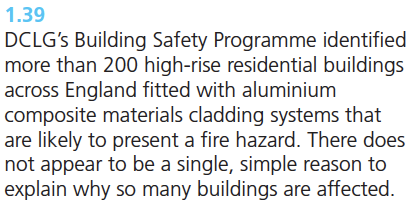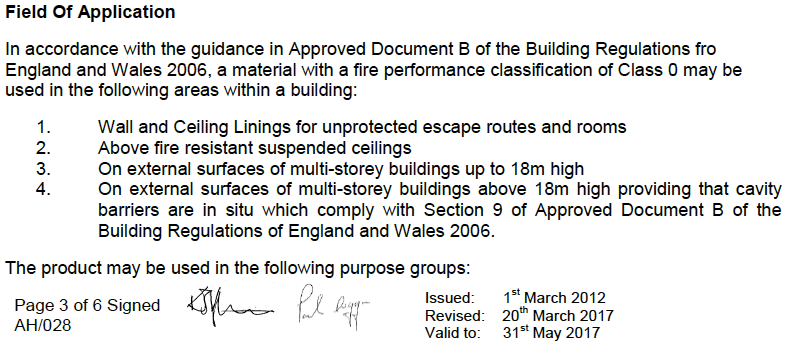Since 18 June 2017, just four days after the Grenfell Tower fire, the Government has been claiming that its Approved Document guidance does not permit the use of combustible ACM cladding on high rise buildings. On 27 June the Communities Secretary Sajid Javid appointed an ‘independent expert advisory panel’ to advise the government on what immediate safety measures needed to be taken to avert the risk of a further tragedy. Under its Terms of Reference, the regulations concerning fire safety and
the use of specific materials
were within the scope of the expert panel’s work:
The Chair of the panel, which appears still to be in operation, is Sir Ken Knight, former London Fire Commissioner and former Government Chief Fire and Rescue Adviser.
On 30 June 2017, the ‘expert panel’ issued a statement in which it referred to the ACM core as the ‘filler’ of the panels:
If the ACM core were a ‘filler’, then it would follow that ACM panels would be required under the official guidance to be of ‘limited combustibility’. Just this requirement is stipulated for ‘filler material’ under paragraph 12.7 of Approved Document B2:
In its Explanatory Note issued on the same day, 30 June, the DCLG referred to three types of ACM panel on the market, of which only one would meet the limited combustibility requirement that it also, like the expert panel, claimed was contained in the Approved Document guidance:
To be of ‘limited combustibility’, as defined in AD B2 Table A7, an ACM panel must be of Euro Class A2 or above, since aluminium composite material is not capable of surviving the 750° C furnace test required to achieve the ‘limited combustibility’ class under the national route to compliance. To achieve A2 under the European classification standard EN 13501-1, the calorific value (heat of combustion) of the core must be tested to EN ISO 1716 and found to be ≤ 3 MJ/kg (since the alternative European route again involves a 750° C furnace test):
Categories 1 to 3 were defined precisely in Appendix B (‘ACM panel screening test results’) of the BRE’s Report on the first in its series of 7 large-scale BS 8414-1 cladding system tests conducted for the DCLG:
The criterion for Category 1, that calorific potential should be ≤ 3 MJ/kg, corresponds exactly to the relevant criterion for Euro Class A2, and thus for ‘limited combustibility’.
This definition of categories is followed by what strikes me as a rather peculiar insertion by the BRE of its client the DCLG’s ‘view’ that only Category 1 cladding material meets ‘the limited combustibility requirement of AD B2’:
On 24 June Sajid Javid announced that all samples tested from 34 buildings had failed the combustibility test, and the number had risen to 60 by the next day, and to 95 a further two days later. The Prime Minister
said that:
What we’ve seen from the investigations that have taken place of cladding material in tower blocks across the country is that we’ve seen so far one hundred per cent of these materials being combustible. Something has clearly gone wrong over a number of years and we need to find out what, why and how to make sure it doesn’t happen again.
On 28 July, the government announced a so-called ‘independent’ review of building regulations and fire safety, to be led by Dame Judith Hackitt. According to its Terms of Reference, the review was commissioned in the light of
the system failures which have been revealed by testing
after the Grenfell fire. In her Interim Report of 18 December 2017, Judith Hackitt said that the testing programme had revealed ‘widespread use’ of ACM which, she claimed (p. 5), did not meet
the limited combustibility requirements of building regulations guidance
But her ‘widespread use’ is inaccurate and possibly disingenuous because the reality is that the use of combustible ACM was more or less universal. Even now, the MHCLG data still show the number of buildings in England with limited combustibility Category 1 cladding as precisely zero. (Columns 1 and 4 concern the series of large-scale system tests conducted by the BRE for the DCLG. The Category of the ACM core, shown in Column 2, was determined by the small-scale sample tests, with numbers for each in Column 5.)
This zero total poses the uncomfortable question in its starkest form: how was it that the limited combustibility requirement for cladding (if such a requirement really existed) was so universally flouted? Judith Hackitt, in her Interim Report, in similar terms to those in her Terms of Reference, found this supposed non-compliance to be evidence of ‘systemic failures in the regulatory system’ (p. 5):
She drew attention to there being more than 200 high rise residential buildings with dangerous cladding systems incorporating ACM, but could find no ‘single, simple reason’ for this.
A simple reason
Jonathan Evans, who holds a Cambridge University Engineering PhD, is Chairman and CEO of Ash & Lacy, who manufacture, among other products, a range of engineered facade systems. In a review of the Hackitt Interim Report, he protested that there was indeed one simple reason why so many buildings were clad with hazardous ACM, and that reason was that the Approved Document had (at least before Grenfell) allowed combustible cladding, contrary to the government’s claim:
This is obvious from the text of AD B2 which, once again, reads:
It is immediately apparent from its heading that this paragraph is directed to insulation materials and products, and not to the outer cladding. The government has attempted to argue otherwise on the basis of three distinct rationales:
i) the ACM core is a filler;
ii) the ACM core is an insulation material;
iii) all elements of cladding systems are covered by the clause, with no justification stated. Up to now, I have worked on the assumption that reliance was being placed on the et cetera to extend the coverage of the clause to the outer cladding. 1
I have addressed all three rationales in four posts (here, here, and here, with a follow-up here) and have shown I believe that none of them can be sustained. It was with interest then that I read the recent letter from Judith Hackitt to Clive Betts MP, Chair of the Communities and Local Government Select Committee, in which on the one hand, she held to the position that products of limited combustibility must be used in (high rise) cladding systems under the Linear Route:
while on the other she appears to have abandoned the pretence (as I am forced to view it) that the ACM core is a filler or an insulation material, and resorted to mere assertion that:
The scope of paragraph 12.7 extends to cladding
with the weakest of additional justification, in the form of an appeal to the cautionary remarks of 12.5:
It is time to put an end to this charade, and the issue may perhaps be forced by the discovery of an Exova Warringtonfire Certificate for a combustible ACM panel, signed by Ken Knight, and authorising the product for use on high rise buildings, on the basis of its national Class 0 Reaction to Fire classification:
I plan to examine this certificate more minutely in my next post, but suffice to say that the manufacturer’s web-site confirms that the product, ‘Alubond usa FR Euroclass B’, is indeed Euroclass B, as its name implies:
and therefore combustible. The Approved Documents, since their inception in 1985, have permitted combustible cladding products such as these to be used on high rise buildings, if they carry the national Class 0 fire classification. It is time for the government, Sir Ken Knight, and Dame Judith Hackitt to stop pretending otherwise.
Andrew Chapman
Notes:
- Chris Cook of Newsnight reported reliance being placed on the et cetera in his article on the interpretation of AD B2 12.7. ↩




















